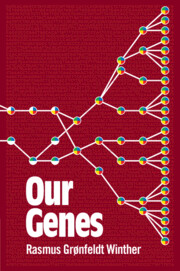Book contents
- Our Genes
- Frontispiece
- Our Genes
- Copyright page
- Dedication
- Contents
- Preface
- 1 Introduction
- 2 Origins and Histories
- 3 The Mind, the Lab, and the Field: Three Kinds of Populations
- 4 Metrics and Measures
- 5 Models and Methodologies
- 6 Six Patterns of Human Genomic Variation
- 7 Natural Selection
- 8 Intelligence, Female Orgasm, and Future Discovery
- 9 Is Race Real?
- 10 The Conscious Universe: Genes in Complex Systems
- References
- Index
- Plate Section (PDF Only)
3 - The Mind, the Lab, and the Field: Three Kinds of Populations
Published online by Cambridge University Press: 14 December 2022
- Our Genes
- Frontispiece
- Our Genes
- Copyright page
- Dedication
- Contents
- Preface
- 1 Introduction
- 2 Origins and Histories
- 3 The Mind, the Lab, and the Field: Three Kinds of Populations
- 4 Metrics and Measures
- 5 Models and Methodologies
- 6 Six Patterns of Human Genomic Variation
- 7 Natural Selection
- 8 Intelligence, Female Orgasm, and Future Discovery
- 9 Is Race Real?
- 10 The Conscious Universe: Genes in Complex Systems
- References
- Index
- Plate Section (PDF Only)
Summary
Clearly, when we stand at the intersection of human evolutionary genomics and philosophy and ask Who are we? we implicitly acknowledge that in body, mind, and history, we are fundamentally relational. Perhaps paradoxically and certainly provocatively, we are not really individuals at all: Connections, relations, and larger holistic and pluralistic systems are as important to your and my reality as the internal subjectivity many of us feel. In terms of the genetic paradigm, a single individual out of relationship with others is of little evolutionary or ecological significance. A single individual needs other individuals for behavioral and psychological interactions, competition and cooperation, and reproduction (Figure 3.1, chapter opener). Populations are a unique organizational level because most, if not all, local interaction happens at this level.
- Type
- Chapter
- Information
- Our GenesA Philosophical Perspective on Human Evolutionary Genomics, pp. 72 - 97Publisher: Cambridge University PressPrint publication year: 2022

